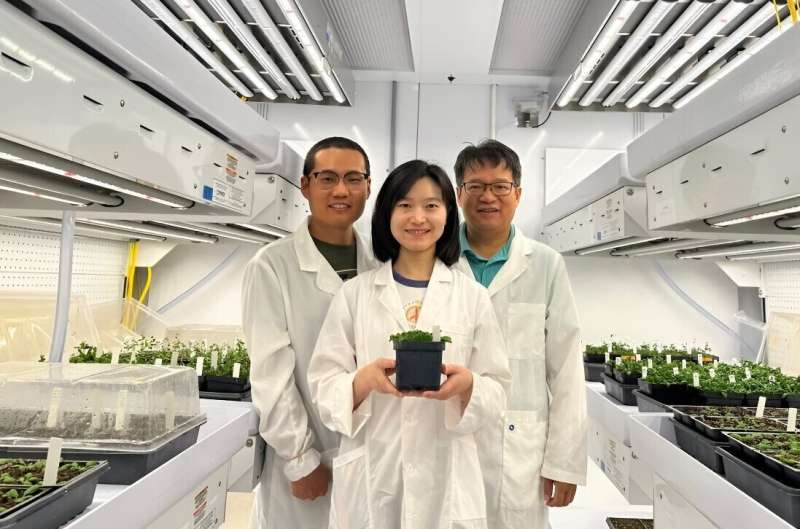This article has been reviewed according to Science X's editorial process and policies. Editors have highlighted the following attributes while ensuring the content's credibility:
fact-checked
peer-reviewed publication
trusted source
proofread
MicroRNA study sets stage for crop improvements

MicroRNAs can make plants more capable of withstanding drought, salinity, pathogens and more. However, in a study published in Nature Plants, Texas A&M AgriLife Research scientists show just how much we didn't know about the intricate processes plants use to produce them.
MicroRNAs are small molecules that can guide proteins to decrease gene expression, and engineering artificial versions allows scientists to target specific genes for crop improvement.
"Though these microRNA molecules are very tiny, their impacts are huge," said Xiuren Zhang, Ph.D., Christine Richardson Endowed Professor in the Texas A&M College of Agriculture and Life Sciences Department of Biochemistry and Biophysics, adjunct professor in the Texas A&M College of Arts and Sciences Department of Biology, and principal investigator of the study.
Using precise mutations and a clever experimental design, Texas A&M AgriLife researchers reevaluated the landscape of microRNAs in the model organism Arabidopsis thaliana and found that fewer than half of them were correctly identified as microRNAs, while the others are miscategorized or require further investigation.
In addition to clarifying genuine microRNA molecules in Arabidopsis thaliana, the study supplies an effective experimental design for repeating the analysis in other crops and even in animals, which likely need a similar review. The team's discoveries also helped them create updated guidelines for designing artificial microRNAs, opening the door to improvement in crops like corn, wheat, soybeans and rice.
Xingxing Yan, a graduate research assistant, and Changhao Li, Ph.D., a postdoctoral research associate, were co-first authors of the study.
A decade-old endeavor
MicroRNAs have a uniform length of around 21 to 24 nucleotides. But in plants, Zhang said their precursors come in a range of shapes and sizes.
Because of the precursors' structural diversity, determining which key features are most important for their processing has been a challenge, and it's left the question of how microRNAs are generated in plants largely unexplored and unverified.
About 10 years ago, Zhang said, he and his lab found a pattern between a loop on the precursor microRNA structure and the first cut site. This initial cut is significant because it determines the first nucleotide on the mature microRNA molecule, an important factor for directing it to the correct location in a cell.
Unfortunately, of the 326 posited microRNA precursors in Arabidopsis thaliana, only a few had the ideal reference loop that Zhang's lab found—according to the computational models, at least.
"The models are based on pure chemistry," Zhang said. "They focus only on the free energy, on what should be the most stable form. But it couldn't explain why so many diverse precursors can end up with products of the same size."
Rather than relying on the models, Zhang's lab sought to verify the microRNA precursors within plants. They wanted to find the first cut sites on the precursors and confirm their structural determinants within cells.
Unexpected findings
To do this, the researchers made highly specific mutations to the dicer protein, which, as its name implies, is responsible for making precise cuts to the microRNA precursor. Normally, the protein acts like two hands that hold a double strand of precursor RNA and cut at a site in each strand concurrently before releasing the RNA molecule.
"We made point mutations at two locations separately in the dicer-like protein to make them semi-active," Yan said. "That way, they can only cut one strand and stop before further processing. This gives us a chance to capture the intermediate products of the microRNA precursor, telling us the initial processing sites and that first nucleotide."
Their results showed that only 147 of the 326 posited microRNA precursors interact with the dicer protein definitively, marking these as genuine microRNA precursors. Eighty-one didn't interact at all, suggesting they should be reclassified as a different type of RNA. Around 100 require further investigation.
The team also used an advanced high-throughput technique and new computational method to map out the structures of microRNA precursors in their natural cell conditions and found that, of the 147 genuine microRNA molecules, about 95% of their structures in cells differed from computer predictions.
"We found several results quite different from predictions and from the literature," Li said. "We were able to combine biochemical results with next-generation sequencing to get more information, and now our understanding of the structures is much more accurate."
The future
The team still has more microRNA precursors to validate in Arabidopsis thaliana, but Zhang said they are excited to pursue collaborations to investigate microRNA processing in agricultural crops for more practical applications.
"We want to find out more about what kind of microRNAs are in other crops, how they're processed and how we can make artificial microRNAs in them," he said.
"This study provides resources that can be used widely, and now we can use it to revisit other crops, find what needs to be corrected, and see what else we can do with this tool."
More information: Xingxing Yan et al, Parallel degradome-seq and DMS-MaPseq substantially revise the miRNA biogenesis atlas in Arabidopsis, Nature Plants (2024). DOI: 10.1038/s41477-024-01725-9
Journal information: Nature Plants
Provided by Texas A&M University



















